Moscow Road, London, England
Photographer: David Roberts
Location: No.16 Moscow Road, London, England
Source: David Roberts/POPPUBLISHING
Palm Avenue, West Hollywood
Photographer: Henry Diltz
Location: Palm Avenue, West Hollywood
Source: PopSpotsnyc.com, mmusicmac.com, rhinomedia.com and 4WaySite
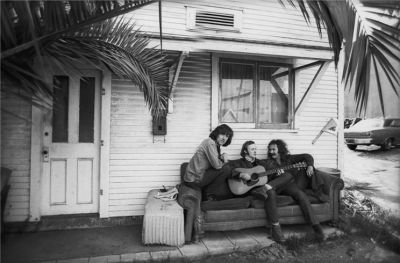 While driving around Hollywood with album designer Gary Burden, Graham Nash spotted an old abandoned house near the corner Palm Avenue and Santa Monica Boulevard, Hollywood. While driving around Hollywood with album designer Gary Burden, Graham Nash spotted an old abandoned house near the corner Palm Avenue and Santa Monica Boulevard, Hollywood.Graham Nash: “Henry Diltz photographed us on a sofa outside an old abandoned house on Santa Monica Boulevard close by the Santa Monica car wash, but when we saw the shots, we realized we were in the wrong order for the name.We went right back to re-shoot it but the house had been torn down, so on the cover of the first album I’m Crosby, David is Nash and Stephen is the only one with the right name over his head.” |
 The house was 150 Feet north of Santa Monica Boulevard on Palm Avenue, on the west side of the street. The car wash is still there and is right across the street. The house was 150 Feet north of Santa Monica Boulevard on Palm Avenue, on the west side of the street. The car wash is still there and is right across the street. |
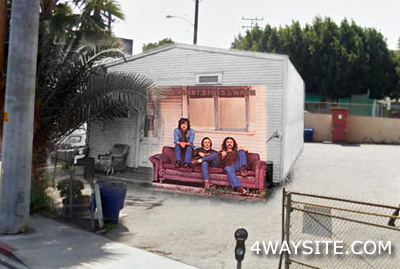 Photomontage of the “couch album”: album cover and black-and-white outtake, both by © Henry Diltz, combined with a view from Google Street Maps of the parking lot.The small house, built for local railroad workers is no long there. The space is now an open parking lot.But, had the house remained, this is what it the view might have looked like today, along with the album cover. 4WaySite added a small side wall to the house (via popspotnyc.com) to show depth. Photomontage of the “couch album”: album cover and black-and-white outtake, both by © Henry Diltz, combined with a view from Google Street Maps of the parking lot.The small house, built for local railroad workers is no long there. The space is now an open parking lot.But, had the house remained, this is what it the view might have looked like today, along with the album cover. 4WaySite added a small side wall to the house (via popspotnyc.com) to show depth. |
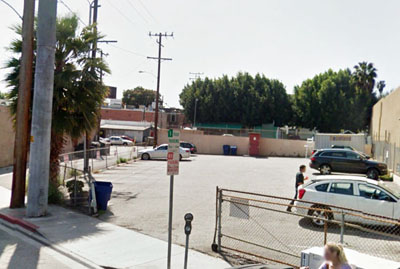 The empty parking lot… The empty parking lot… |
Bleecker Street, New York City
Year: 1969
Location: Bleecker Street, New York City
Source: Shakey: Neil Young’s Biography (Jimmy McDonough), Wikipedia and 4WaySite
 Graham Nash: “I spent one morning at breakfast with Neil on Bleecker Street in New York City and when we were finished I was completely sold on Neil joining. He was incredibly funny and very committed to music. He wanted to be a full member of the band with equal billing etc. This made sense to me and so we became CSNY. Graham Nash: “I spent one morning at breakfast with Neil on Bleecker Street in New York City and when we were finished I was completely sold on Neil joining. He was incredibly funny and very committed to music. He wanted to be a full member of the band with equal billing etc. This made sense to me and so we became CSNY.Neil’s effect on the band was immediate and very fulfilling. He adds a certain edge to the sound and, of course, he is an incredible musician. We became a better band because of the inclusion of Neil Young.” The exact place is subject to investigation. |
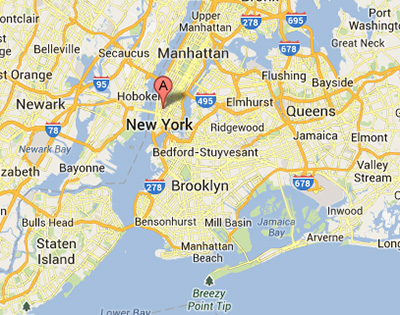 Bleecker Street is a west-east street in New York City borough of Manhattan. It is most famous today as a Greenwich Village nightclub district. The street connects a neighborhood today popular for music venues and comedy, but which was once a major center for American bohemia. Bleecker Street is a west-east street in New York City borough of Manhattan. It is most famous today as a Greenwich Village nightclub district. The street connects a neighborhood today popular for music venues and comedy, but which was once a major center for American bohemia. |
Novato, California
Location: Novato, California
Photographer: ©Tom Gundelfinger/O’Neil
Sources: 4WaySite, Tom O’Neil, Debbie Donovan, Bob Egan of PopSpotsnyc.com and Paul Dionne, and the books Long Time Gone, Crosby, Stills & Nash: The Biography and Crosby Stills Nash and sometimes Young
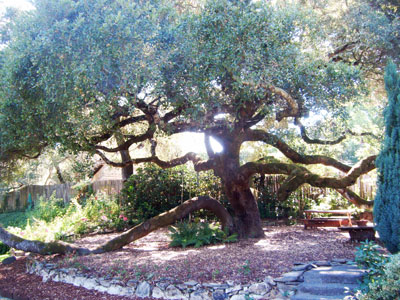 There are many famous trees in the world, such as the Anne Frank Tree in my native Holland but for the CSNY fan, the Déjà Vu tree is the most important in the world.The Déjà Vu photo was taken in the backyard on the property David Crosby was renting in Novato California in 1969-1970. Novato is about 15 miles north of San Francisco in Marin Country.This how the tree looks today There are many famous trees in the world, such as the Anne Frank Tree in my native Holland but for the CSNY fan, the Déjà Vu tree is the most important in the world.The Déjà Vu photo was taken in the backyard on the property David Crosby was renting in Novato California in 1969-1970. Novato is about 15 miles north of San Francisco in Marin Country.This how the tree looks today |
T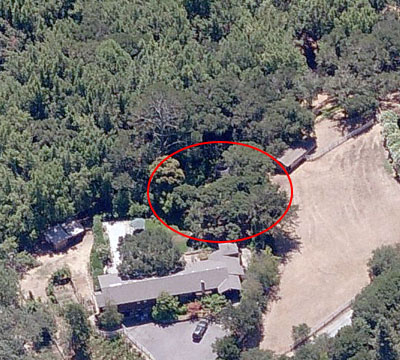 he current owner is the son of the man who rented it to Crosby and writes in to 4WaySite: “The tree has lost some limbs – yet has kept it’s mystical charm and impresses almost everyone who sees it.” Here is the backyard where the Déjà Vu photo was taken. The owner of the house further writes to 4WaySite: “My parents somehow got in with the local rock & roll network, as our house was also leased by members of The Grateful Dead, and Dave Mason. Steve Miller lived up the hill from us for a time during the late 70’s. Neil Schon and another Journey band member also lived nearby. My parents bought the property in the early 60’s (c. 1962) as a second home and winter rental property. I can remember my father talking about the lease for the house to CSN. He had a ‘NO CROSBY’ clause built into the lease preventing David from setting foot on the property. Crosby had a reputation for trashing places and my father wanted to keep the house in tact. Well, as you can see, that clause was ignored. However, all our living room furniture was removed and placed in the open air car port during the time they were there. Needless to say the furniture did not do well in the car port.” he current owner is the son of the man who rented it to Crosby and writes in to 4WaySite: “The tree has lost some limbs – yet has kept it’s mystical charm and impresses almost everyone who sees it.” Here is the backyard where the Déjà Vu photo was taken. The owner of the house further writes to 4WaySite: “My parents somehow got in with the local rock & roll network, as our house was also leased by members of The Grateful Dead, and Dave Mason. Steve Miller lived up the hill from us for a time during the late 70’s. Neil Schon and another Journey band member also lived nearby. My parents bought the property in the early 60’s (c. 1962) as a second home and winter rental property. I can remember my father talking about the lease for the house to CSN. He had a ‘NO CROSBY’ clause built into the lease preventing David from setting foot on the property. Crosby had a reputation for trashing places and my father wanted to keep the house in tact. Well, as you can see, that clause was ignored. However, all our living room furniture was removed and placed in the open air car port during the time they were there. Needless to say the furniture did not do well in the car port.” |
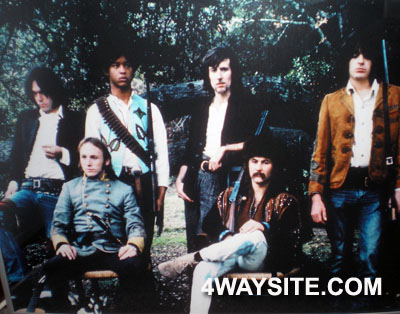 After visiting a costume store, they congregated in Crosby’s backyard. Each member had been transformed: Crosby into Buffalo Bill Cody (complete with rifle), Stills into a Confederate soldier, Nash into a pipe-smoking worker, Young a cagey gunfighter.Again the owner of the house: “The chest used as a prop in the photo, belongs to us and is still in the house.” After visiting a costume store, they congregated in Crosby’s backyard. Each member had been transformed: Crosby into Buffalo Bill Cody (complete with rifle), Stills into a Confederate soldier, Nash into a pipe-smoking worker, Young a cagey gunfighter.Again the owner of the house: “The chest used as a prop in the photo, belongs to us and is still in the house.” |
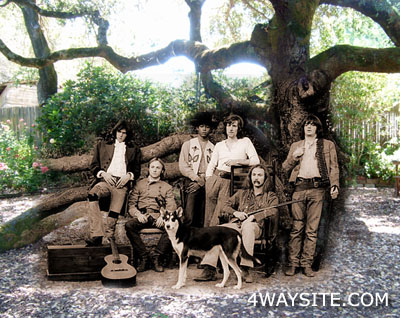 Photomontage of the location. Déjà vu all over again… Photomontage of the location. Déjà vu all over again… |
A town in North Ontario
Source: Nick Kent and Wikipedia
Location: North Ontario
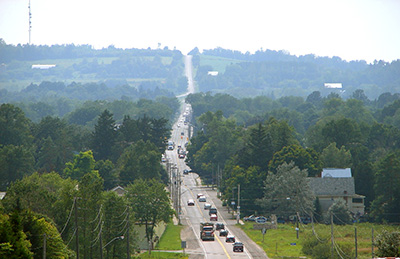 The “town in North Ontario” referred to in the opening line of the song is often presumed to be Ontario native Young’s hometown; Young himself cleared up the rumors in a 1995 Mojo interview with Nick Kent: “Well, it’s not literally a specific town so much as a feeling. Actually, it’s a couple of towns. Omemee, Ontario, is one of them. It’s where I first went to school and spent my ‘formative’ years. Actually I was born in Toronto…”. Omemee, just west of Peterborough, is well within what is now considered Southern Ontario, and 130 km from Toronto by road. The “town in North Ontario” referred to in the opening line of the song is often presumed to be Ontario native Young’s hometown; Young himself cleared up the rumors in a 1995 Mojo interview with Nick Kent: “Well, it’s not literally a specific town so much as a feeling. Actually, it’s a couple of towns. Omemee, Ontario, is one of them. It’s where I first went to school and spent my ‘formative’ years. Actually I was born in Toronto…”. Omemee, just west of Peterborough, is well within what is now considered Southern Ontario, and 130 km from Toronto by road. |
New York City, New York
Photographer: Joel Bernstein
Location: corner of Sullivan Street and West 3rd Street, Greenwich Village, New York
Source: PopSpotsnyc.com
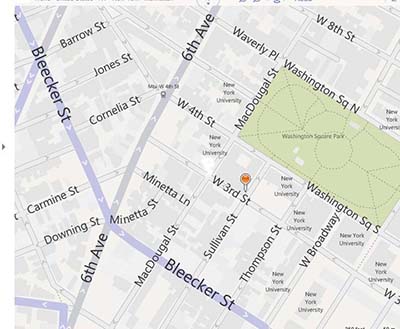 The photo was taken by photographer Joel Bernstein, most likely sometime in early 1970, as the album came out in August of that year.In the book: “Shakey: Neil Young’s Biography”, author Jimmy McDonough writes that Bernstein, 18-years-old at the time, was “shocked” that Neil chose that photo for the cover. Bernstein described it as an “accidental shot” of Neil walking through Greenwich Village (during an outdoor photo session) and he even “solarized the print in order to hide its soft focus.” The photo was taken by photographer Joel Bernstein, most likely sometime in early 1970, as the album came out in August of that year.In the book: “Shakey: Neil Young’s Biography”, author Jimmy McDonough writes that Bernstein, 18-years-old at the time, was “shocked” that Neil chose that photo for the cover. Bernstein described it as an “accidental shot” of Neil walking through Greenwich Village (during an outdoor photo session) and he even “solarized the print in order to hide its soft focus.” |
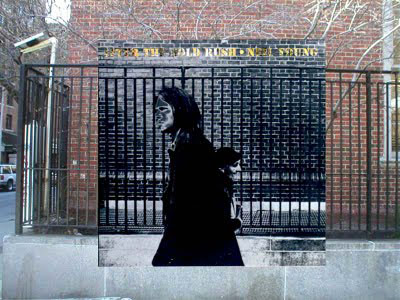 Joel Bernstein recently wrote to Bob Egan (PopSpotsnyc.com): “The photo was not a ‘mistake.’ I saw the small, old woman coming towards us down the sidewalk, was intrigued, and wanted to catch her passing Neil. The mistake, to me, was that I had in my haste focused the lens just past the two figures, closer to the fence than to Neil’s face. That was the original reason why I made a small-sized print and solarized it; to help with the apparent sharpness. But the solarization in this case added a somewhat spooky dimension to the image, which Neil took to immediately.” Joel Bernstein recently wrote to Bob Egan (PopSpotsnyc.com): “The photo was not a ‘mistake.’ I saw the small, old woman coming towards us down the sidewalk, was intrigued, and wanted to catch her passing Neil. The mistake, to me, was that I had in my haste focused the lens just past the two figures, closer to the fence than to Neil’s face. That was the original reason why I made a small-sized print and solarized it; to help with the apparent sharpness. But the solarization in this case added a somewhat spooky dimension to the image, which Neil took to immediately.” |
Mill Valley, California
Year: 1971
Source: Wikipedia
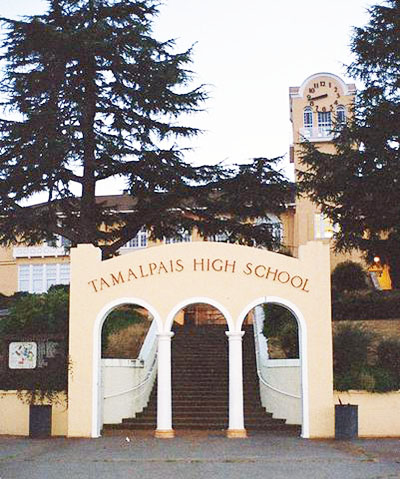 Tamalpais High School (often abbreviated as Tam) is a public secondary school located in Mill Valley, California. It is named after nearby Mount Tamalpais, which rises more than 2,500 feet (760 m) above Mill Valley. David Crosby’s song, “Tamalpais High (At About 3),” refers to when Tam classes end for the day, and was conceived while the musician passed the school on the way to recording sessions in neighboring Sausalito, reportedly at The Plant Studios. Tamalpais High School (often abbreviated as Tam) is a public secondary school located in Mill Valley, California. It is named after nearby Mount Tamalpais, which rises more than 2,500 feet (760 m) above Mill Valley. David Crosby’s song, “Tamalpais High (At About 3),” refers to when Tam classes end for the day, and was conceived while the musician passed the school on the way to recording sessions in neighboring Sausalito, reportedly at The Plant Studios. |
Manassas, Virginia
Photographer: Ira H. Wexler
Location: 9451 West St., Manassas, Virginia
Source: greatamericanstations.com, wikipedia.org and 4waysite.com
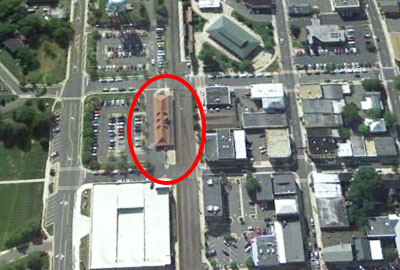 Stephen was a big Civil War buff and Manassas is the initial land battle of the American Civil War. In July of 1861, this tiny railroad community became one of the most important places in American history as the site of historic battles in the Civil War.The Manassas Station Operations included the operations known as Bristoe Station, Kettle Run, Bull Run Bridge, or Union Mills. It took place August 25–27, 1862, in Prince William County, Virginia. After the Civil War, the first depot on the present site was a long frame building constructed in the 1880s. On June 25, 1914 a fire broke out in the baggage room and the depot burned, leaving only the foundation and walls. Stephen was a big Civil War buff and Manassas is the initial land battle of the American Civil War. In July of 1861, this tiny railroad community became one of the most important places in American history as the site of historic battles in the Civil War.The Manassas Station Operations included the operations known as Bristoe Station, Kettle Run, Bull Run Bridge, or Union Mills. It took place August 25–27, 1862, in Prince William County, Virginia. After the Civil War, the first depot on the present site was a long frame building constructed in the 1880s. On June 25, 1914 a fire broke out in the baggage room and the depot burned, leaving only the foundation and walls. |
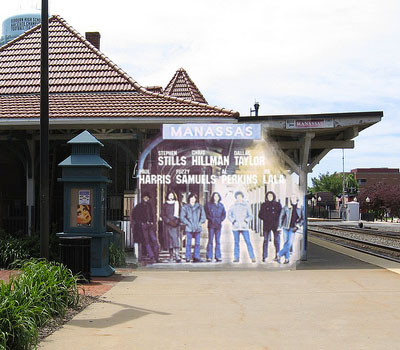 Work on the third and present depot was completed in October 1914, in a red-brick Victorian style with a ceramic tile-covered hipped roof. The structure partially incorporated the walls of the burned depot, which measured about 20 feet by 77 feet, and had four new rooms; an office, a ladies’ waiting room, men’s waiting room and a baggage and express room. The “new” structure is about 32 feet longer than the earlier one permitting a modified room arrangement and included the addition of an umbrella shed on the front and east side, the installation of electric lights, and an attractive tile roof.. Work on the third and present depot was completed in October 1914, in a red-brick Victorian style with a ceramic tile-covered hipped roof. The structure partially incorporated the walls of the burned depot, which measured about 20 feet by 77 feet, and had four new rooms; an office, a ladies’ waiting room, men’s waiting room and a baggage and express room. The “new” structure is about 32 feet longer than the earlier one permitting a modified room arrangement and included the addition of an umbrella shed on the front and east side, the installation of electric lights, and an attractive tile roof.. |
Lahaina, Hawaii
Photographer: Harry Harris/Graham Nash (see story) and Geoff Moore
Location: Baby Beach, Lahaina, Maui, Hawai
Source: 4WaySite with the assistance of Bob Egan of PopSpotsnyc.com
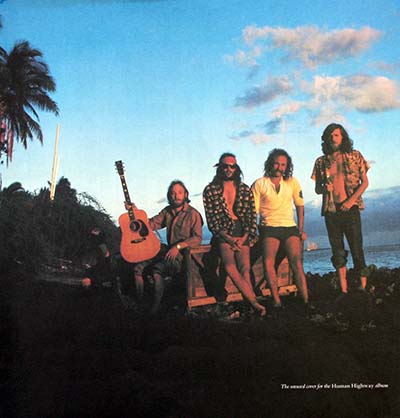 Human Highway was the (working?) title of the album CSNY worked on in 1973. The band rehearsed in Maui at an old beach house Neil Young rented and on Crosby’s schooner. Later at Neil’s ranch they also recorded some tracks. CSNY produced some exceptionally strong material but the album was shelved prior to completion and was abandoned. The virtual track listing can be found in this section. Human Highway was the (working?) title of the album CSNY worked on in 1973. The band rehearsed in Maui at an old beach house Neil Young rented and on Crosby’s schooner. Later at Neil’s ranch they also recorded some tracks. CSNY produced some exceptionally strong material but the album was shelved prior to completion and was abandoned. The virtual track listing can be found in this section. |
 After quite some research and thanks to some kind locals, we found out the photo was taken at the so called “Baby Beach” where Neil Young rented a house. After quite some research and thanks to some kind locals, we found out the photo was taken at the so called “Baby Beach” where Neil Young rented a house. |
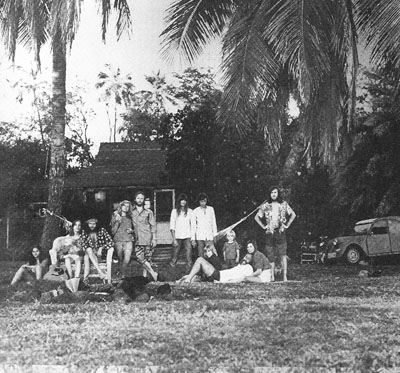 Graham Nash to 4WaySite: “The photograph was taken not far from the Pioneer Inn in Maui, Hawaii… we were all there rehearsing for the album… Neil had rented a house on the beach…on Friday at sunset, our last day, I decided that it would be a good idea to photograph ourselves. Stephen had his Hasselblad camera with him and I borrowed it. I figured out the exposure and placed the camera on the ground… I arranged it so that we would all be in the shot and had my friend Harry Harris press the trigger… there were only two shots left… one is the shot you’re talking about and the other is one of us and the family members who were also there outside the rented house. In the shot that was released, our friend Gary Burden airbrushed out the young son of Gwen Roberts who was Elliot Roberts girlfriend… the child was to the left of the shot partially hidden behind Stephen”. Graham Nash to 4WaySite: “The photograph was taken not far from the Pioneer Inn in Maui, Hawaii… we were all there rehearsing for the album… Neil had rented a house on the beach…on Friday at sunset, our last day, I decided that it would be a good idea to photograph ourselves. Stephen had his Hasselblad camera with him and I borrowed it. I figured out the exposure and placed the camera on the ground… I arranged it so that we would all be in the shot and had my friend Harry Harris press the trigger… there were only two shots left… one is the shot you’re talking about and the other is one of us and the family members who were also there outside the rented house. In the shot that was released, our friend Gary Burden airbrushed out the young son of Gwen Roberts who was Elliot Roberts girlfriend… the child was to the left of the shot partially hidden behind Stephen”. |
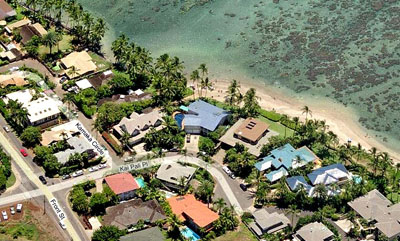 The home was a plantation home belonging to t he Lindsey family as the father of the family was one of the managers of the Pioneer Mill.Now the area is a small subdivision of upscale homes and the street is called Kai Pali Place. The old beach house is gone. The home was a plantation home belonging to t he Lindsey family as the father of the family was one of the managers of the Pioneer Mill.Now the area is a small subdivision of upscale homes and the street is called Kai Pali Place. The old beach house is gone. |
Photomontage (thanks for the photo, Geoff!) of the place of what would have been the cover shot for the album Human Highway taken along Baby Beach, Lahaina, Maui. 1973:
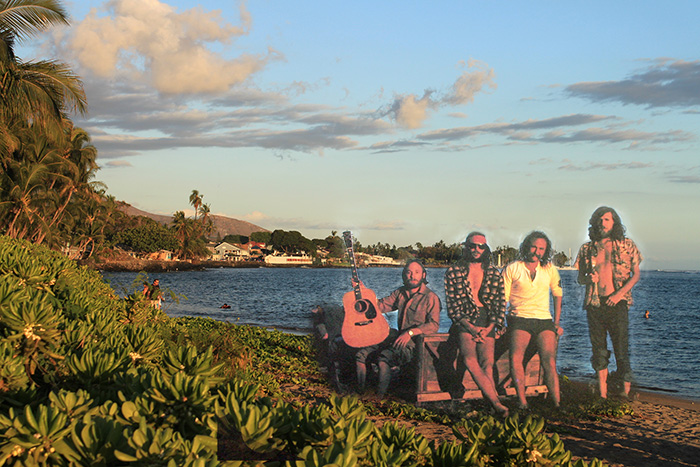
Santa Monica Beach, CA
Photographer: Bob Seidemann
Location: Santa Monica Beach, CA
Source: wordmagazine.co.uk, Wikipedia, santamonica.com, theendofbeing.com, thrasherswheat.org and 4WaySite
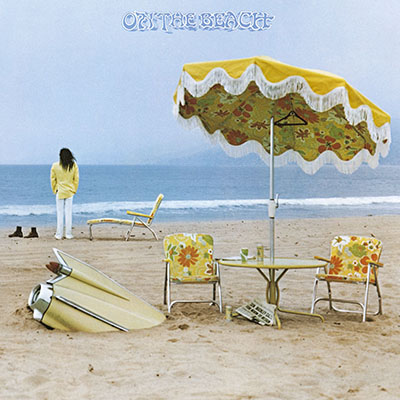 On The Beach is Neil’s fifth studio album It was unavailable on compact disc until it was released as a HDCD-encoded remastered version on August 19, 2003 as part of his Archives Digital Masterpiece Series. On The Beach is Neil’s fifth studio album It was unavailable on compact disc until it was released as a HDCD-encoded remastered version on August 19, 2003 as part of his Archives Digital Masterpiece Series. |
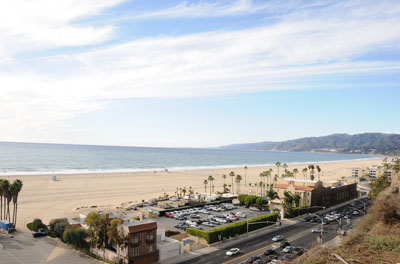 Santa Monica has 3.5 miles (5.6 km) of well-maintained California beach locations and enjoys on average 340 days of sunshine a year plus a nearly constant gentle ocean breeze. Cycling, movie shoots, beach volleyball games, and the finest of people-watching all happen here, and it’s no wonder. People love to gather at this California beach, partially because it is so pristine. Santa Monica has 3.5 miles (5.6 km) of well-maintained California beach locations and enjoys on average 340 days of sunshine a year plus a nearly constant gentle ocean breeze. Cycling, movie shoots, beach volleyball games, and the finest of people-watching all happen here, and it’s no wonder. People love to gather at this California beach, partially because it is so pristine. |
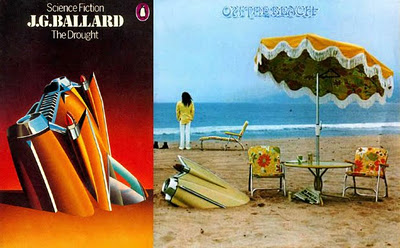 From thrasherswheat.org: Neil Young’s “On The Beach” album cover is considered to be one of his most creative and intriguing designs in his vast catalog. It would seem that many of his album covers have a rather tossed off feel. For example, the “Living With War” cover is literally stenciled letters on a brown paper bag. In contrast, “On The Beach” album is meticulously designed right down to the inside of the album jacket matching the pattern of the inside of the umbrella on the cover. “On The Beach” — the final link of Neil Young’s Ditch Trilogy — is considered by many fans to be one of his best and their most favorite of all Neil Young album covers and artwork. Designed by Gary Burden, photographed by Bob Seideman, and graphic lettering by Rick Griffin, the cover is quite enigmatic with a Cadillac car fin jutting from the sand like a crashed rocket being buried by time. A shoeless Neil stares out into the ocean near a forlorn potted palm. A jaunty yellow beach umbrella matches Neil’s jacket. The yellow theme is even continued with a Coors beer can on the table. Inside the album, things become even more crpytic with the album’s liner notes. Fans have poured over Rusty Kershaw’s strange handwritten note for clues and meaning often to no avail. Apparently, the recording sessions’ heavy use of Honey Slides took a toll … possibly to the creative sides’ benefit? From thrasherswheat.org: Neil Young’s “On The Beach” album cover is considered to be one of his most creative and intriguing designs in his vast catalog. It would seem that many of his album covers have a rather tossed off feel. For example, the “Living With War” cover is literally stenciled letters on a brown paper bag. In contrast, “On The Beach” album is meticulously designed right down to the inside of the album jacket matching the pattern of the inside of the umbrella on the cover. “On The Beach” — the final link of Neil Young’s Ditch Trilogy — is considered by many fans to be one of his best and their most favorite of all Neil Young album covers and artwork. Designed by Gary Burden, photographed by Bob Seideman, and graphic lettering by Rick Griffin, the cover is quite enigmatic with a Cadillac car fin jutting from the sand like a crashed rocket being buried by time. A shoeless Neil stares out into the ocean near a forlorn potted palm. A jaunty yellow beach umbrella matches Neil’s jacket. The yellow theme is even continued with a Coors beer can on the table. Inside the album, things become even more crpytic with the album’s liner notes. Fans have poured over Rusty Kershaw’s strange handwritten note for clues and meaning often to no avail. Apparently, the recording sessions’ heavy use of Honey Slides took a toll … possibly to the creative sides’ benefit? |
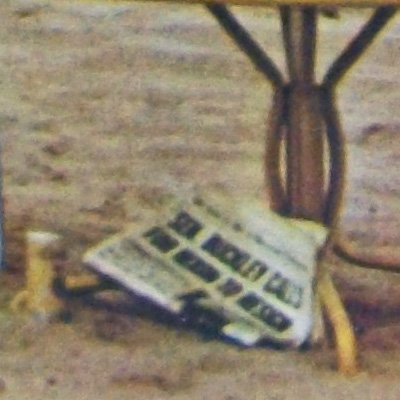 From thrasherswheat.org: But probably the most significant item on the cover is the newspaper’s headline “Senator Buckley Calls for Nixon to Resign”. (Young and Nixon have had a bitter and strange relationship over the years. From “Ohio” ‘s lyrics “Tin soldiers and Nixon’s coming” to “Campaigner’s” lines “Even Richard Nixon has got soul”, Neil has never made a secret of his feelings towards U.S. President Richard Nixon.) |
 Photomontage of the approximate location. On the beach…. |
Winnipeg, Canada
Location: 220 Main Street, Winnipeg, Canada
Source: winnipegfreepress.com and 4WaySite
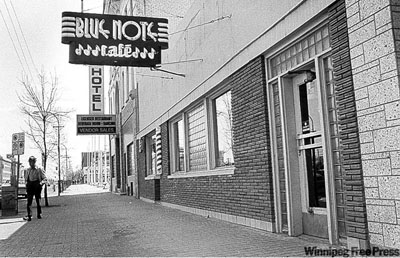 Neil Young was known to play unannounced in the Blue Note Café while in Winnipeg. This is the Blue Note Café in 1989. Neil Young was known to play unannounced in the Blue Note Café while in Winnipeg. This is the Blue Note Café in 1989. |
 Later the Blue Note Café moved to another location, and the establishment turned into the Fat Angel. Later the Blue Note Café moved to another location, and the establishment turned into the Fat Angel. |
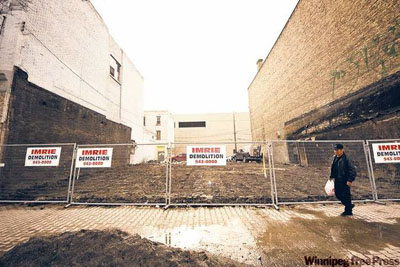 The former Blue Note Cafe was unceremoniously torn down in March/April, 2011. A gaping hole is all that remains at the site of a Winnipeg music institution. The former Blue Note Cafe was unceremoniously torn down in March/April, 2011. A gaping hole is all that remains at the site of a Winnipeg music institution. |
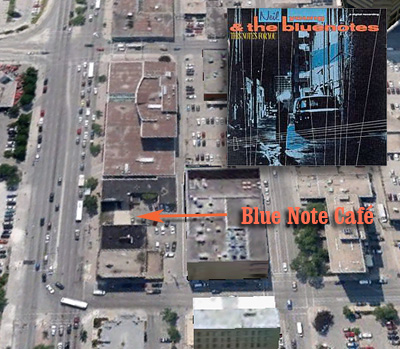 Many websites, quite reasonably, have suggested that the cover of This Note’s For Youwas supposedly taken in the alley behind the Blue Note Café, where Neil would most likely have hung out after doing a set. But 4WaySite discovered the cover photo was shot somewhere completely else. Just scroll down… Many websites, quite reasonably, have suggested that the cover of This Note’s For Youwas supposedly taken in the alley behind the Blue Note Café, where Neil would most likely have hung out after doing a set. But 4WaySite discovered the cover photo was shot somewhere completely else. Just scroll down… |
Austin, Texas
Location: between East 5th St and East 4th St, Austin, Texas
Photographer: Bob Scott
Source: Bob Scott, David Bright, 4WaySite with the assistance of Bob Egan of PopSpotsnyc.com
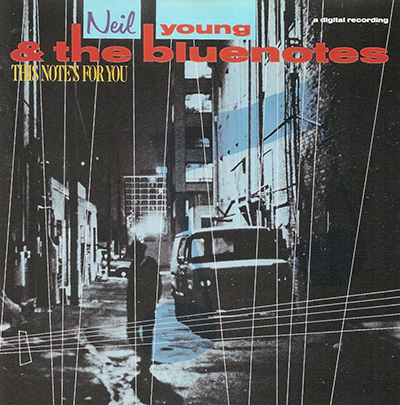 Contrary to popular belief, the photo was not shot behind the Blue Note Café in Winnipeg. David Bright: “An old friend of mine, Bob Scott (or “Bosco” as he was professionally known) who lived in Austin, Texas and worked in graphic design, was out shooting photos one night in downtown Austin, and, while walking down an alleyway took a photo of his friend Clinton Winstruck, a fellow Austinite. “. Contrary to popular belief, the photo was not shot behind the Blue Note Café in Winnipeg. David Bright: “An old friend of mine, Bob Scott (or “Bosco” as he was professionally known) who lived in Austin, Texas and worked in graphic design, was out shooting photos one night in downtown Austin, and, while walking down an alleyway took a photo of his friend Clinton Winstruck, a fellow Austinite. “. |
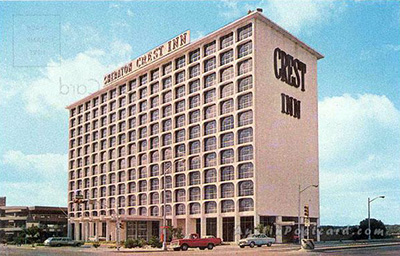 David Bright: “The building in the background is the Raddison Hotel on East Cesar Chavez (the old 1st Street), which still looks like that. It would be easy to figure out exactly where Clinto (as everyone called him) was standing at that moment and where Bob was when he snapped it.” It started as the Sheraton Crest then changed into a Radisson in 1992. David Bright: “The building in the background is the Raddison Hotel on East Cesar Chavez (the old 1st Street), which still looks like that. It would be easy to figure out exactly where Clinto (as everyone called him) was standing at that moment and where Bob was when he snapped it.” It started as the Sheraton Crest then changed into a Radisson in 1992. |
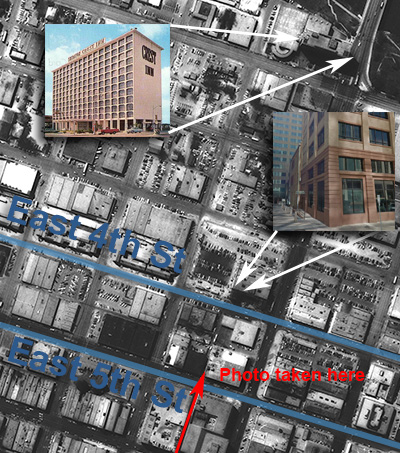 But it was quite a challenge to find the exact place of where the photo was taken. A few clues: the Sheraton Crest and another building (see other inserted photo) that we can see in the background of the cover photo. This is where the photo was taken. But it was quite a challenge to find the exact place of where the photo was taken. A few clues: the Sheraton Crest and another building (see other inserted photo) that we can see in the background of the cover photo. This is where the photo was taken. |
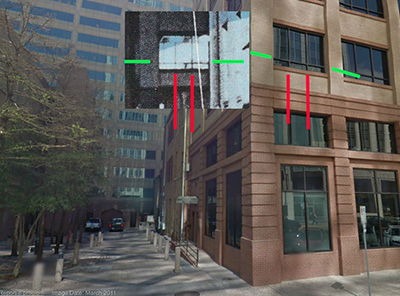 Another clue: the windows that match. Bob Scott: “The landscape had changed dramatically. The landscape in the background of the photo where The Radisson is, has been obscured with new buildings it appears.” Another clue: the windows that match. Bob Scott: “The landscape had changed dramatically. The landscape in the background of the photo where The Radisson is, has been obscured with new buildings it appears.” |
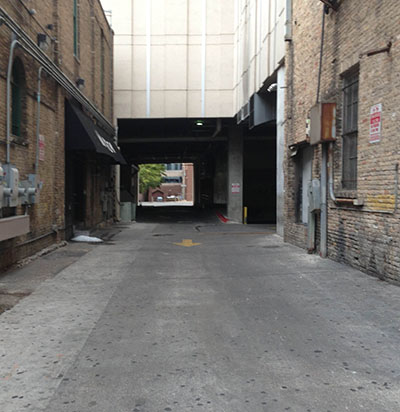 This is a famous CSNY place, without – of course – CSN and.. without Neil Young. (Thanks for the photo, Emily). This is a famous CSNY place, without – of course – CSN and.. without Neil Young. (Thanks for the photo, Emily). |
| David Bright: “I remember seeing the black and white photo at Bob’s house around that time, and I think he was considering making it into a poster of some type. A few years later, after Bob had moved to San Francisco, he showed the photo to Larry Cragg, whom he had become friends with through music, and Larry showed it to Neil and the rest is history. The lines on the picture were all done after the fact. |
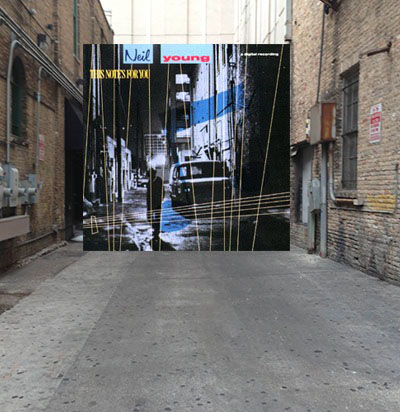 Photomontage of the location with Clinto. Photomontage of the location with Clinto. |
| But here’s the best part. After the record came out, Bob told his old pal Clinto that he was on the cover of the new Neil Young record, and Clinto said – I shit you not – ‘Neil who?’”. |
Washington, DC
Location: 1600 Pennsylvania Ave NW, Washington, DC
Source: jimmycarterlibrary.gov and Crosby, Stills & Nash: The Biography (Dave Zimmer)
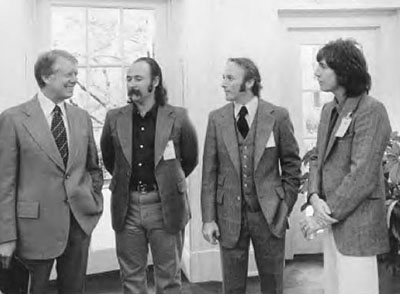 With the next leg of the CSN touring about to begin, Stills was busy arranging a surprise for his cohorts: a visit with the President of the United States. CSNY had spent so much of their carreers denouncing the policies of the Unites States government, it seemed inconceivable that they would ever enter the White House, let alone the Oval Office. On June 9, 1977 CSN met President Jimmy Carter in the White House. With the next leg of the CSN touring about to begin, Stills was busy arranging a surprise for his cohorts: a visit with the President of the United States. CSNY had spent so much of their carreers denouncing the policies of the Unites States government, it seemed inconceivable that they would ever enter the White House, let alone the Oval Office. On June 9, 1977 CSN met President Jimmy Carter in the White House. |
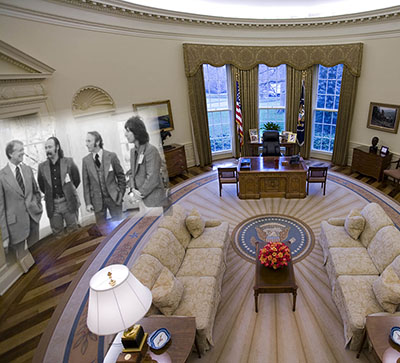 Photomontage with CSN at the absolute location! Photomontage with CSN at the absolute location! |
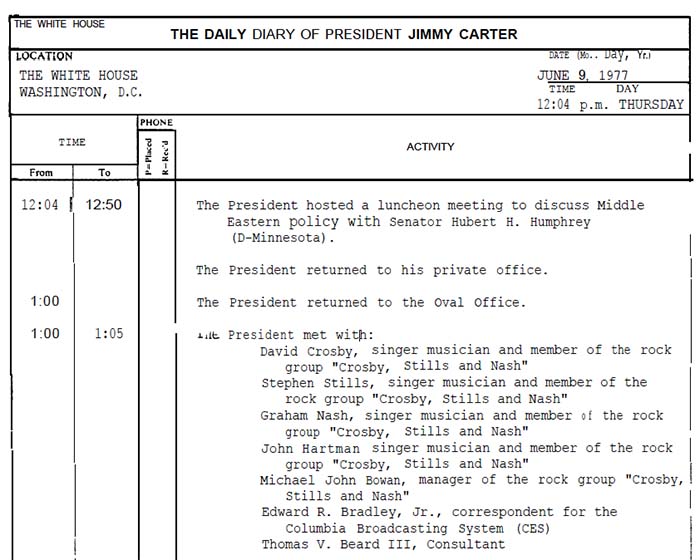
Topanga, CA
Location: Santa Monica Mountains, Los Angeles County, California
Photographer: unknown
Source: Bob Egan of PopSpotsnyc.com with the assistance of 4WaySite
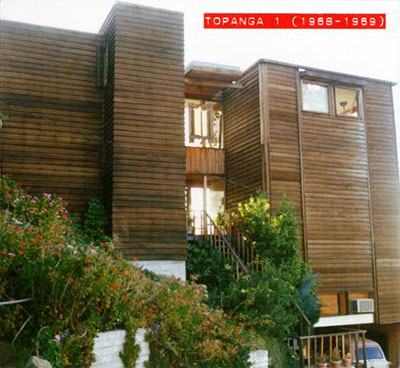 For a time, Neil Young lived in Topanga, first living with producer David Briggs then later buying his own house. He would record most of his After the Gold Rush album in his basement studio in 1970. For a time, Neil Young lived in Topanga, first living with producer David Briggs then later buying his own house. He would record most of his After the Gold Rush album in his basement studio in 1970. |
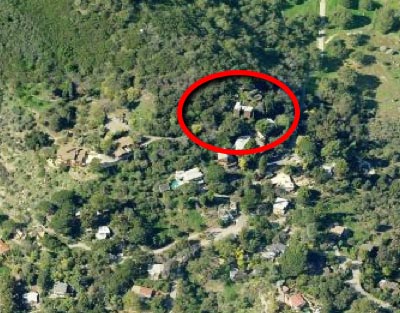 The house was typical Neil: a redwood box situated on top of an extremely steep hill overlooking the canyon. Tom Willkies: “It’s a totally ridiculous piece of architecture. Three stories, skinny, straight ip like a quart of milk. I can’t believe it hasn’t fallen down the hill.” Neil Young, Bernie Leadon, and Patti Davis all lived here. As Patti Davis said in her autobiography, “There are so many windows in this house, its like living outside. Every room has a stunning view.” Later on the house was owned by Bernie Leadon of the Eagles, who sold it to the current owner. Perfect Fernwood location, close-in yet on a very quiet street. It doesn’t get more Topanga than this. The house was typical Neil: a redwood box situated on top of an extremely steep hill overlooking the canyon. Tom Willkies: “It’s a totally ridiculous piece of architecture. Three stories, skinny, straight ip like a quart of milk. I can’t believe it hasn’t fallen down the hill.” Neil Young, Bernie Leadon, and Patti Davis all lived here. As Patti Davis said in her autobiography, “There are so many windows in this house, its like living outside. Every room has a stunning view.” Later on the house was owned by Bernie Leadon of the Eagles, who sold it to the current owner. Perfect Fernwood location, close-in yet on a very quiet street. It doesn’t get more Topanga than this. |
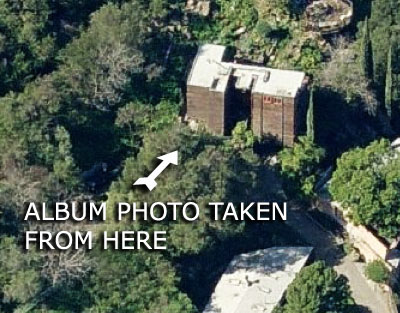 There’s a broad entertainment deck off the living room and dining room, beyond that, a short trail leads to a lookout point with a big deck, hot tub, and a romantic hide-away you can sleep in. One wall of the hide-away is built into solid rock. The 1,532 sq. ft. two-story wood and glass architectural house has three bedrooms, two baths, and a spacious kitchen. In addition, there is a two-room 520 sq. ft. music studio tucked in below the house built by Neil Young. There’s a broad entertainment deck off the living room and dining room, beyond that, a short trail leads to a lookout point with a big deck, hot tub, and a romantic hide-away you can sleep in. One wall of the hide-away is built into solid rock. The 1,532 sq. ft. two-story wood and glass architectural house has three bedrooms, two baths, and a spacious kitchen. In addition, there is a two-room 520 sq. ft. music studio tucked in below the house built by Neil Young. |
Santa Barbara, CA
Location: Santa Barbara harbor, CA
Source: 4WaySite, wsj.com and yachtworld.com
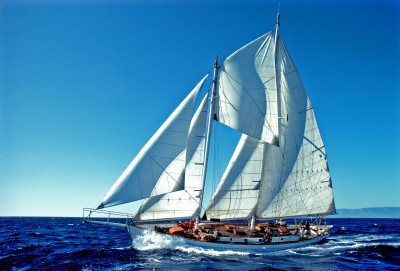 David Crosby bought the Mayan in 1968. In his first bio he writes of sailing through the Panama Canal with Joni Mitchell and Graham Nash in 1969 and 1970. Imagine the music made on that trip. David Crosby bought the Mayan in 1968. In his first bio he writes of sailing through the Panama Canal with Joni Mitchell and Graham Nash in 1969 and 1970. Imagine the music made on that trip. |
 David Crosby: “I was a natural sailor, and it’s one of the reasons I later wrote ‘Déjà Vu.’” David Crosby: “I was a natural sailor, and it’s one of the reasons I later wrote ‘Déjà Vu.’”After forty years of ownership, David Crosby has decided that it is time for this magnificent sailboat to become part of someone else’s life. Many of David’s songs have been created on board this spiritual platform. These are the songs he wrote on the Mayan:”The Lee-shore” “Wooden Ships” “Carry Me” “Page 43″ “Shadow Captain” “Rusty and Blue” “That House” |
A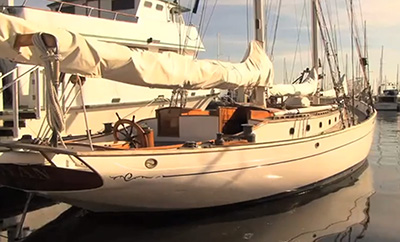 David Crosby: “I still take the Mayan out sailing every chance I get with my wife, Jan, and Django, our son. But honestly, I haven’t been able to afford the boat’s upkeep for a while given my mortgage and other expenses. It’s been on the market for a few years, but my wife would break my arms if I actually sold it.” David Crosby: “I still take the Mayan out sailing every chance I get with my wife, Jan, and Django, our son. But honestly, I haven’t been able to afford the boat’s upkeep for a while given my mortgage and other expenses. It’s been on the market for a few years, but my wife would break my arms if I actually sold it.”
In 2014 David Crosby finally sold The Mayan. He said in an exclusive interview to 4WaySite: “Very painful. Not a happy thing at all. I had it for like 45 years. Sailed it all over, half of the world. And I didn’t want to sell it but, you know, at a certain point you have to pretend you’re a grown up.” |

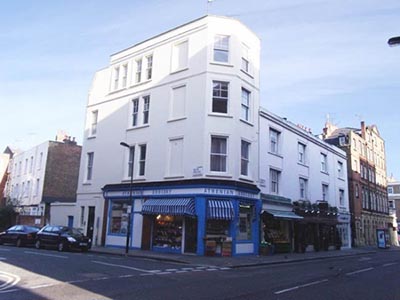 No.16 Moscow Road, at the junction with Salem Road in London’s Bayswater area is CSN decamped in the early Winter of 1968.
No.16 Moscow Road, at the junction with Salem Road in London’s Bayswater area is CSN decamped in the early Winter of 1968.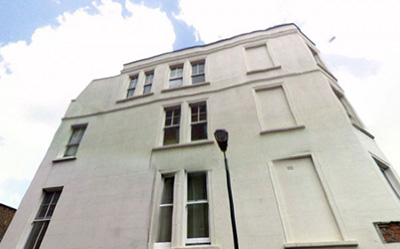 he tiny top floor flat was where the three practiced songs from what would become their debut album while entertaining visitors including The Beatles (Screen capture from Google Maps ©).
he tiny top floor flat was where the three practiced songs from what would become their debut album while entertaining visitors including The Beatles (Screen capture from Google Maps ©). 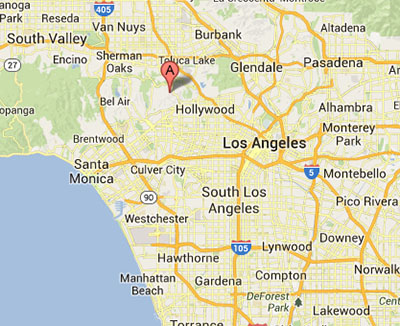 Graham Nash lived with Joni Mitchell in a house on Lookout Mountain, Los Angeles. While Joni Mitchell was writing her famous oeuvre there, Nash was inspired to write his own Canyon ditty, the domestically romantic “Our House” (1970).
Graham Nash lived with Joni Mitchell in a house on Lookout Mountain, Los Angeles. While Joni Mitchell was writing her famous oeuvre there, Nash was inspired to write his own Canyon ditty, the domestically romantic “Our House” (1970).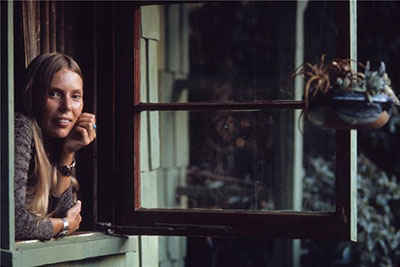 Joni in an iconic photo.Taken in the window of her home.
Joni in an iconic photo.Taken in the window of her home.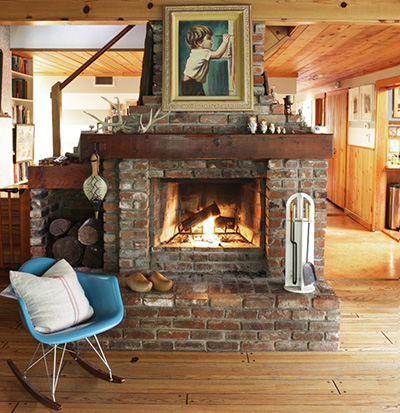 “I’ll light the fire…” The fireplace as it looks today.Graham Nash shares the story behind the song in an audio interview recorded in conjunction with Michael Walker’s book: “Once you walked into that front door, everything disappeared …and then I started to think, you know, God, that’s an incredibly domestic scene, you know, here we are, Joni Mitchell and Graham Nash, and I’m, you know, put flowers in the vase and light the fire and stuff, and I thought, but you know, I love this woman, and this moment is a very grounded moment… in our relationship, and… I sat down at the piano and, an hour later, ‘Our House’ was done.”
“I’ll light the fire…” The fireplace as it looks today.Graham Nash shares the story behind the song in an audio interview recorded in conjunction with Michael Walker’s book: “Once you walked into that front door, everything disappeared …and then I started to think, you know, God, that’s an incredibly domestic scene, you know, here we are, Joni Mitchell and Graham Nash, and I’m, you know, put flowers in the vase and light the fire and stuff, and I thought, but you know, I love this woman, and this moment is a very grounded moment… in our relationship, and… I sat down at the piano and, an hour later, ‘Our House’ was done.”